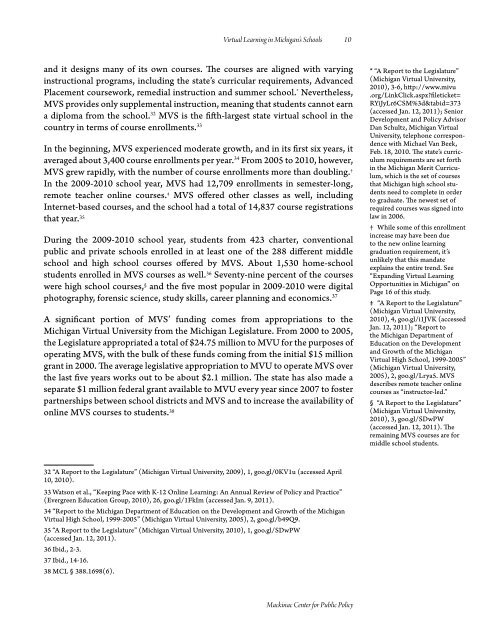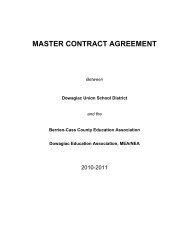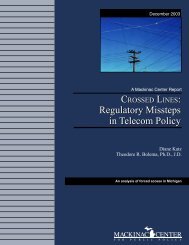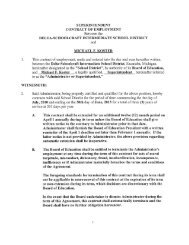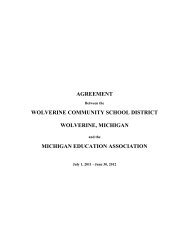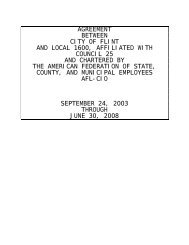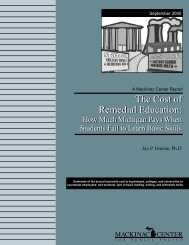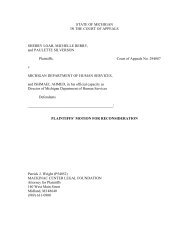by Michael Van Beek - Michigan Virtual University
by Michael Van Beek - Michigan Virtual University
by Michael Van Beek - Michigan Virtual University
Create successful ePaper yourself
Turn your PDF publications into a flip-book with our unique Google optimized e-Paper software.
<strong>Virtual</strong> Learning in <strong>Michigan</strong>’s Schools 10and it designs many of its own courses. The courses are aligned with varyinginstructional programs, including the state’s curricular requirements, AdvancedPlacement coursework, remedial instruction and summer school. * Nevertheless,MVS provides only supplemental instruction, meaning that students cannot earna diploma from the school. 32 MVS is the fifth-largest state virtual school in thecountry in terms of course enrollments. 33In the beginning, MVS experienced moderate growth, and in its first six years, itaveraged about 3,400 course enrollments per year. 34 From 2005 to 2010, however,MVS grew rapidly, with the number of course enrollments more than doubling. †In the 2009-2010 school year, MVS had 12,709 enrollments in semester-long,remote teacher online courses. ‡ MVS offered other classes as well, includingInternet-based courses, and the school had a total of 14,837 course registrationsthat year. 35During the 2009-2010 school year, students from 423 charter, conventionalpublic and private schools enrolled in at least one of the 288 different middleschool and high school courses offered <strong>by</strong> MVS. About 1,530 home-schoolstudents enrolled in MVS courses as well. 36 Seventy-nine percent of the courseswere high school courses, § and the five most popular in 2009-2010 were digitalphotography, forensic science, study skills, career planning and economics. 37A significant portion of MVS’ funding comes from appropriations to the<strong>Michigan</strong> <strong>Virtual</strong> <strong>University</strong> from the <strong>Michigan</strong> Legislature. From 2000 to 2005,the Legislature appropriated a total of $24.75 million to MVU for the purposes ofoperating MVS, with the bulk of these funds coming from the initial $15 milliongrant in 2000. The average legislative appropriation to MVU to operate MVS overthe last five years works out to be about $2.1 million. The state has also made aseparate $1 million federal grant available to MVU every year since 2007 to fosterpartnerships between school districts and MVS and to increase the availability ofonline MVS courses to students. 38* “A Report to the Legislature”(<strong>Michigan</strong> <strong>Virtual</strong> <strong>University</strong>,2010), 3-6, http://www.mivu.org/LinkClick.aspx?fileticket=RYiJyLr6CSM%3d&tabid=373(accessed Jan. 12, 2011); SeniorDevelopment and Policy AdvisorDan Schultz, <strong>Michigan</strong> <strong>Virtual</strong><strong>University</strong>, telephone correspondencewith <strong>Michael</strong> <strong>Van</strong> <strong>Beek</strong>,Feb. 18, 2010. The state’s curriculumrequirements are set forthin the <strong>Michigan</strong> Merit Curriculum,which is the set of coursesthat <strong>Michigan</strong> high school studentsneed to complete in orderto graduate. The newest set ofrequired courses was signed intolaw in 2006.† While some of this enrollmentincrease may have been dueto the new online learninggraduation requirement, it’sunlikely that this mandateexplains the entire trend. See“Expanding <strong>Virtual</strong> LearningOpportunities in <strong>Michigan</strong>” onPage 16 of this study.‡ “A Report to the Legislature”(<strong>Michigan</strong> <strong>Virtual</strong> <strong>University</strong>,2010), 4, goo.gl/i1JVK (accessedJan. 12, 2011); “Report tothe <strong>Michigan</strong> Department ofEducation on the Developmentand Growth of the <strong>Michigan</strong><strong>Virtual</strong> High School, 1999-2005”(<strong>Michigan</strong> <strong>Virtual</strong> <strong>University</strong>,2005), 2, goo.gl/Lrya5. MVSdescribes remote teacher onlinecourses as “instructor-led.”§ “A Report to the Legislature”(<strong>Michigan</strong> <strong>Virtual</strong> <strong>University</strong>,2010), 3, goo.gl/SDwPW(accessed Jan. 12, 2011). Theremaining MVS courses are formiddle school students.32 “A Report to the Legislature” (<strong>Michigan</strong> <strong>Virtual</strong> <strong>University</strong>, 2009), 1, goo.gl/0KV1u (accessed April10, 2010).33 Watson et al., “Keeping Pace with K-12 Online Learning: An Annual Review of Policy and Practice”(Evergreen Education Group, 2010), 26, goo.gl/1FkIm (accessed Jan. 9, 2011).34 “Report to the <strong>Michigan</strong> Department of Education on the Development and Growth of the <strong>Michigan</strong><strong>Virtual</strong> High School, 1999-2005” (<strong>Michigan</strong> <strong>Virtual</strong> <strong>University</strong>, 2005), 2, goo.gl/b49Q9.35 “A Report to the Legislature” (<strong>Michigan</strong> <strong>Virtual</strong> <strong>University</strong>, 2010), 1, goo.gl/SDwPW(accessed Jan. 12, 2011).36 Ibid., 2-3.37 Ibid., 14-16.38 MCL § 388.1698(6).Mackinac Center for Public Policy


